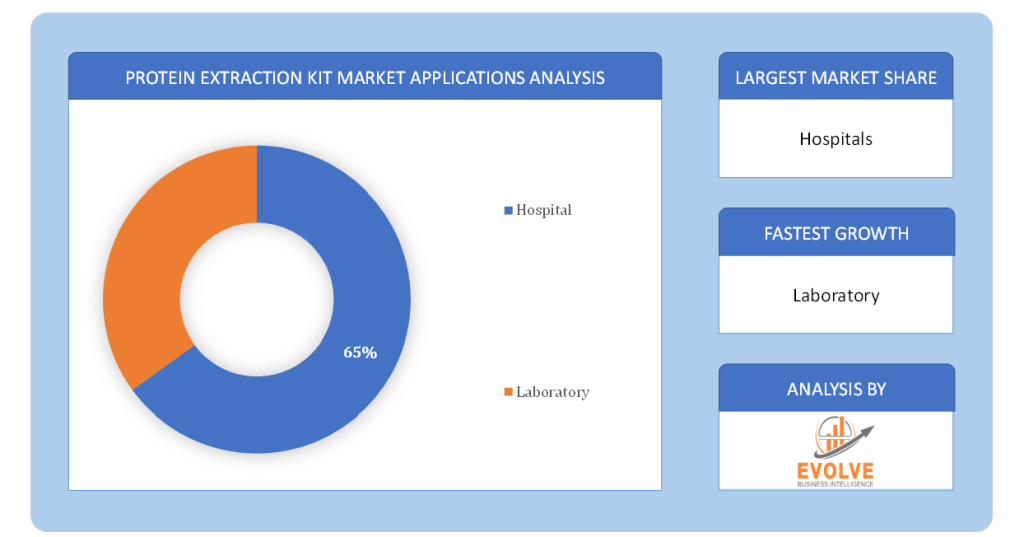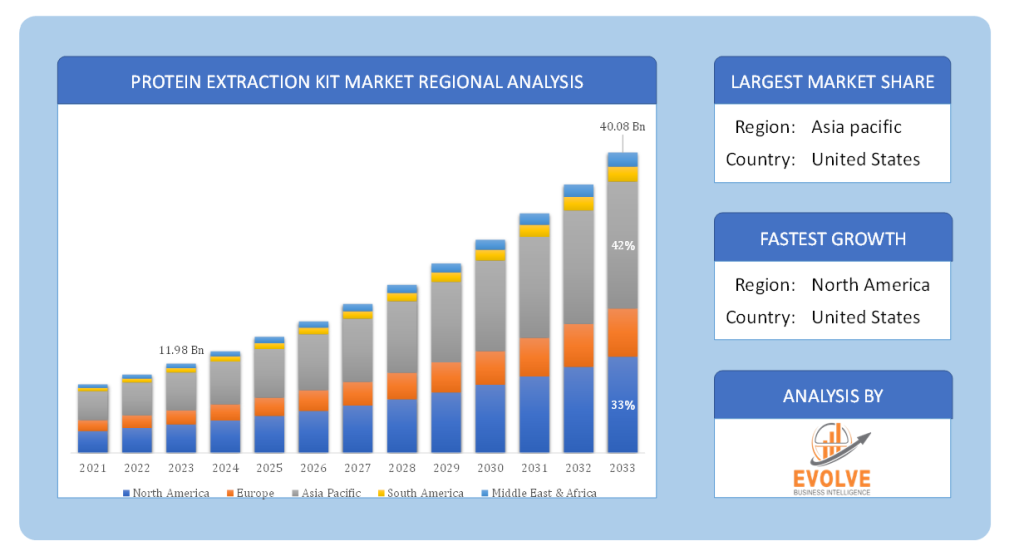Protein Extraction Kit Market Overview
The global Protein Extraction Kit Market Size is expected to reach USD 40.08 Billion by 2033. The global Protein Extraction Kitindustry size accounted for USD 11.98 Billion in 2023 and is expected to expand at a compound annual growth rate (CAGR) of 12.84% from 2023 to 2033. The Protein Extraction Kit Market has witnessed substantial growth over the years, owing to the increasing demand for efficient protein extraction techniques in various fields of biotechnology research. Protein extraction kits are essential tools used in laboratories to extract, purify, and isolate proteins from various sources such as cells, tissues, and biological fluids. These kits provide researchers with a streamlined and standardized method to obtain high-quality protein samples, which are crucial for various applications including drug discovery, diagnostics, proteomics, and genomics.
Protein extraction kits are designed to optimize protein yield while maintaining their integrity and functionality. They provide researchers with a convenient and reliable solution for protein extraction, eliminating the need for complex and time-consuming manual procedures. These kits typically include reagents and buffers that facilitate protein extraction, along with detailed protocols to guide users through the process. With the advancements in biotechnology research and the increasing need for protein-based therapeutics, the Protein Extraction Kit Market is poised for significant growth in the coming years.
Global Protein Extraction Kit Market Synopsis
The COVID-19 pandemic has had a profound impact on various industries, including the biotechnology sector. The Protein Extraction Kit Market also experienced fluctuations due to disruptions in the global supply chain and temporary closure of research facilities. However, as the world adapts to the new normal, the market is expected to rebound and witness steady growth in the post-COVID scenario. The demand for protein extraction kits is likely to increase as researchers and pharmaceutical companies focus on developing innovative therapies and vaccines.
Protein Extraction Kit Market Dynamics
The major factors that have impacted the growth of Protein Extraction Kit are as follows:
Drivers:
Ø Advancements in Proteomics Research
One of the key driving factors for the Protein Extraction Kit Market is the rapid advancements in proteomics research. Proteomics plays a crucial role in understanding the structure, function, and interactions of proteins within biological systems. The growing need for comprehensive proteomic studies has led to increased demand for efficient protein extraction methods. Protein extraction kits offer researchers a reliable and standardized approach to extract proteins from complex samples, enabling them to perform proteomic analyses with high accuracy and reproducibility.
Proteomics research has gained significant traction in various fields, including drug discovery, personalized medicine, and biomarker identification. By analyzing the protein profiles of different samples, researchers can uncover valuable insights into disease mechanisms, identify therapeutic targets, and develop targeted therapies. Protein extraction kits, with their ability to extract high-quality protein samples, are instrumental in facilitating proteomics research and driving advancements in the field.
Restraint:
- High Cost of Protein Extraction Kits Restraining Market Growth
Despite the numerous benefits offered by protein extraction kits, the high cost associated with these kits acts as a restraining factor for market growth. Protein extraction kits are often priced higher compared to traditional protein extraction methods, such as manual homogenization and centrifugation. This cost disparity can pose challenges, especially for small research laboratories or institutions with limited budgets.
The high cost of protein extraction kits can deter researchers from adopting these advanced solutions, leading them to rely on conventional methods that are relatively cheaper. Additionally, the recurring expenses for purchasing replacement kits and reagents can add to the financial burden. Manufacturers in the Protein Extraction Kit Market need to address this concern by exploring cost-effective production methods and offering competitive pricing strategies to make their products more accessible to a wider range of researchers.
Opportunity:
⮚ Increasing Focus on Personalized Medicine
With the increasing focus on personalized medicine, the Protein Extraction Kit Market is presented with significant growth opportunities. Personalized medicine aims to tailor medical treatments to individual patients based on their unique genetic makeup, lifestyle factors, and specific disease characteristics. This approach allows for more targeted and effective therapies, minimizing adverse effects and improving patient outcomes.
Protein extraction kits play a crucial role in personalized medicine by facilitating the extraction and analysis of proteins that serve as biomarkers for disease diagnosis, prognosis, and treatment response. These kits enable researchers to extract high-quality protein samples from patient tissues or biofluids, allowing for the identification and validation of disease-specific protein markers. By analyzing these markers, physicians can make informed decisions regarding personalized treatment strategies, such as selecting the most appropriate drug or adjusting dosage based on individual patient profiles.
Protein Extraction Kit Segment Overview
By Type
Based on the Type, the market is segmented based on Cytoplasmic, and Nuclear. the Cytoplasmic protein extraction kits hold the largest share in the market. Cytoplasmic proteins play a crucial role in various cellular processes, including metabolism, signal transduction, and cell communication. The demand for cytoplasmic protein extraction kits is driven by their significance in understanding cellular functions, studying disease mechanisms, and developing targeted therapies.
By Application
 Based on Application, the market has been divided into Hospital, Laboratory. the Laboratory segment is anticipated to dominate the market. Protein extraction kits are extensively used in research laboratories for various applications, such as protein characterization, enzymatic studies, and protein-based assays. The increasing number of research laboratories and the growing focus on biotechnology research contribute to the dominance of the Laboratory segment in the Protein Extraction Kit Market.
Based on Application, the market has been divided into Hospital, Laboratory. the Laboratory segment is anticipated to dominate the market. Protein extraction kits are extensively used in research laboratories for various applications, such as protein characterization, enzymatic studies, and protein-based assays. The increasing number of research laboratories and the growing focus on biotechnology research contribute to the dominance of the Laboratory segment in the Protein Extraction Kit Market.
Global Protein Extraction Kit Market Regional Analysis
Based on region, the global Protein Extraction Kitmarket has been divided into North America, Europe, Asia-Pacific, South America and Middle East & Africa. Asia-Pacific is projected to dominate the use of the market followed by the Europe and North America regions.
 North America Market
North America Market
North America holds a prominent position in the Protein Extraction Kit Market. The region is characterized by advanced healthcare infrastructure, significant investments in research and development, and a strong presence of key market players. The United States, in particular, dominates the market in North America due to its well-established pharmaceutical and biotechnology industry. The presence of leading research institutions, academic collaborations, and government support for scientific research contribute to the growth of the Protein Extraction Kit Market in this region.
Asia Pacific Market
Asia Pacific is also a significant market for protein extraction kits. Countries such as China, Japan, and India are witnessing rapid growth in the biotechnology sector and an increasing focus on research and development activities. The region benefits from a large patient population, rising investments in healthcare infrastructure, and a growing number of research laboratories. Additionally, the presence of contract research organizations and the expansion of pharmaceutical and biotech companies contribute to the growth of the Protein Extraction Kit Market in Asia Pacific.
Competitive Landscape
The global Protein Extraction Kit market is highly competitive, with numerous players offering a wide range of software solutions. The competitive landscape is characterized by the presence of established companies, as well as emerging startups and niche players. To increase their market position and attract a wide consumer base, the businesses are employing various strategies, such as product launches, and strategic alliances.
Prominent Players:
- Thermo Fisher Scientific
- Merck
- Bio-Rad
- BioChain
- Novus Biologicals
- NtRON Biotechnology
- Boster Bio
- Full Moon BioSystems
- Qiagen
Key Development:
March 2022: Thermo Fisher Scientific is a renowned company that offers a wide range of scientific and laboratory equipment, including protein extraction kits. One of their notable developments in the market was the launch of the Thermo Scientific NE-PER Nuclear and Cytoplasmic Extraction Kit.
Scope of the Report
Global Protein Extraction Kit Market, by Type
- Cytoplasmic
- Nuclear
Global Protein Extraction Kit Market, by Application
- Hospital
- Laboratory
- Clinical
- Other
Global Protein Extraction Kit Market, by Region
- North America
- US
- Canada
- Mexico
- Europe
- UK
- Germany
- France
- Italy
- Spain
- Benelux
- Nordic
- Rest of Europe
- Asia Pacific
- China
- Japan
- South Korea
- Indonesia
- Austalia
- Malaysia
- India
- Rest of Asia Pacific
- South America
- Brazil
- Argentina
- Rest of SouthAmerica
- Middle East &Africa
- Saudi Arabia
- UAE
- Egypt
- SouthAfrica
- Rest of Middle East & Africa
| Parameters | Indicators |
|---|---|
| Market Size | 2033: $40.08 Billion |
| CAGR | 12.84% CAGR (2023-2033) |
| Base year | 2022 |
| Forecast Period | 2023-2033 |
| Historical Data | 2021 |
| Report Coverage | Revenue Forecast, Competitive Landscape, Growth Factors, and Trends |
| Key Segmentations | Type, Application |
| Geographies Covered | North America, Europe, Asia-Pacific, Latin America, Middle East, Africa |
| Key Vendors | Thermo Fisher Scientific, Merck, Bio-Rad, BioChain, Novus Biologicals, NtRON Biotechnology, Boster Bio, Full Moon BioSystems, and Qiagen |
| Key Market Opportunities | Increasing Focus on Personalized Medicine |
| Key Market Drivers | Advancements in Proteomics Research Driving the Protein Extraction Kit Market |
REPORT CONTENT BRIEF:
- High-level analysis of the current and future Protein Extraction Kit market trends and opportunities
- Detailed analysis of current market drivers, restraining factors, and opportunities in the future
- Protein Extraction Kit market historical market size for the year 2021, and forecast from 2023 to 2033
- Protein Extraction Kit market share analysis at each product level
- Competitor analysis with a detailed insight into its product segment, Laboratory strength, and strategies adopted.
- Identifies key strategies adopted including product launches and developments, mergers and acquisitions, joint ventures, collaborations, and partnerships as well as funding taken and investment done, among others.
- To identify and understand the various factors involved in the global Protein Extraction Kit market affected by the pandemic
- To provide a detailed insight into the major companies operating in the market. The profiling will include the Laboratory health of the company’s past 2-3 years with segmental and regional revenue breakup, product offering, recent developments, SWOT analysis, and key strategies.








